|
Rifle shooters today have it better than ever.
There seems to be an almost endless choice in the variety of
rifles available at reasonable prices, and I am always ready to
try out new rifle designs and configurations.
One of the most recent rifles to arrive here at
our palatial offices (the gun room) is a unique new rifle from Sturm,
Ruger, & Company that they call their Frontier Rifle.
It is, in short, a light, handy bolt action carbine that allows
for great latitude in mounting optical sights.
The Frontier Rifle is built on Ruger’s
excellent Model 77 Mark II action, which features a one-piece
bolt with a two lug lockup, a large claw extractor, controlled
round feeding from the magazine, and a fixed-blade ejector. The
safety is a three-position wing type that is easy to use, and
clears any low-mounted scope sight. The Frontier is built
for, above all else, handiness. The rifle is short. The
overall length is just thirty-five and one-half inches.
Grab a yardstick if you have one handy. The Frontier Rifle is
shorter than that. The length of pull is only twelve and
one-half inches, and the medium weight barrel measures just
sixteen and one-half inches long. The forearm on the
handsome black laminated wood stock has also been shortened,
which makes the rifle look more proportional. The barreled
action, pistol grip cap, sling swivel studs, and hinged magazine
floorplate are all made of blued steel. The bolt, extractor,
and trigger are of stainless steel. The butt plate is a dark
gray synthetic rubber. Mounted on the barrel just forward of the
action is a quarter rib, similar to the one on the Number One
single shot rifle. The quarter rib on the Frontier Rifle is
machined to accept the Ruger scope rings that are included with
the rifle, and is drilled and tapped to accept a Picatinny rail
scope base that is also included with the rifle. The rail will
accept any type of Weaver style ring mount, as well as many
military type mounts that are compatible with a Picatinny rail.
Gaining in popularity these days is the forward
mounting of a scope with intermediate eye relief in what has
come to be called the "Scout" concept. The idea behind
this is that it moves the scope forward, allowing greater
peripheral vision, easier access to the action for loading, and
more clearance between the shooter’s eyebrow and the ocular
bell of the scope in heavily recoiling rifles. The quarter rib
on the Frontier rifle allows for just such a setup. Leupold
and Burris make scopes that are purpose-built for such
mounting, and this system makes for very quick target
acquisition. With the scope out front, leaving both eyes open
makes tracking a moving target much easier than trying to do so
through a conventional high-powered scope. Even quicker
than a low-powered scout scope is a good electronic dot sight,
and the rail provided with the Frontier Rifle makes the mounting
of such a sight quick and easy. My all time favorite
electronic dot sight is the rugged Trijicon
Reflex sight. It never needs batteries due to its use of
Tritium illumination, and it is always "on". In
use, both eyes are left open, and the gun is brought to the
shoulder without losing sight of the target. Target acquisition
is instantaneous. In the woods or thick brush, nothing is
faster. The action is, like on all Mark II rifles, machined to
also accept the Ruger scope rings for those wanting to mount a
scope in the conventional over-the-action position.
The Frontier Rifle is built on Ruger‘s short
action, and is currently available chambered for the .243
Winchester, 7mm-08 Remington, .308 Winchester, and .300
Winchester Short Magnum (WSM) cartridges. The sample sent to me
is chambered for the latter cartridge. In addition to the round
in the chamber, the .300 WSM holds three cartridges in the
magazine, the others hold four. The trigger pull on the sample
gun measured a crisp but heavy five pounds and eleven ounces.
The rifle weighed in at six pounds and twelve ounces, without
scope. The balance point on the rifle is right under the action,
making it feel even lighter. It comes to the shoulder very
quickly, like a good English bird gun. The short length of
pull is really appreciated when wearing a heavy hunting coat or
thick jacket.
I was a bit worried that a great deal of
velocity would be lost shooting the .300 WSM from such a short
barrel, and there was some loss, but not as much as I expected.
I fired the ammunition that I had available over the eyes of my PACT
chronograph at a distance of twelve feet, at an air temperature
of 53 degrees Fahrenheit. Velocities are listed in
feet-per-second. The three factory loads tested chronographed as
follows:
| LOAD |
VELOCITY (FPS) |
| Winchester 180 grain Ballistic Silvertip |
2765 |
| Winchester 180 grain Power Point |
2716 |
| Winchester 180 grain AccuBond |
2796 |
This is respectable velocity for the 180 grain
bullets from a sixteen and one-half inch barrel. It is about on
par with a bullet of equal weight from a twenty-four inch
barreled .30-06. To get there, the Frontier .300 WSM uses a few
more grains of powder and operates at higher pressure, but has a
barrel length of seven and one-half inches less and an overall
length of about nine inches less.
For accuracy testing, I mounted a Leupold
VX-II 2-7x32 scope atop the action using the Ruger rings
provided. This is a superb scope for rifles that kick. While the
recoil in the little .300 WSM Frontier Rifle is by no means
punishing, the gun does back up a bit upon firing. This Leupold
scope has almost five inches of eye relief, and that makes it
particularly nice with the shorter than normal length of pull on
the Frontier Rifle. The VX-II has great optical clarity, and is
relatively lightweight, making for a good match to the Frontier.
I really like the low-profile turrets, matte finish, and
positive click adjustments on this Leupold. For the Frontier
Rifle, I can think of no better scope.
Accuracy was good from the little carbine. While
I did no hand loading for the .300 WSM, the factory ammunition
that I had on hand all would group three shots into less than
one inch at one hundred yards from a rested position. Case
feeding and extraction was slick and easy with all shots fired.
Overall, I was impressed with the Frontier
Rifle. I liked it better than I at first thought that I would.
It is light and handy, but not so light as to be hard to shoot
accurately. It comes to the shoulder quickly; very quickly. It
handles as a good carbine should. It is built for hunting. I
have owned a few rifles that were, while accurate, slow to bring
to bear on target due to excessive weight. I had a very accurate
Remington Sendero .25-06 that would have been great on
the open plains, if one had a gun bearer along. However, in the
woods, that rifle handled like swinging a pig on a shovel. It
was out of its place for deer hunting from anything but a
benchrest. The Frontier Rifle is just the opposite. It is every
bit as handy as a good lever action carbine. The buttstock is
short enough for those of smaller stature, such as women and
kids, but is not too short for a six-foot, long-armed male. At
least in the .300 WSM chambering, it is important to grasp the
forearm back away from the sling swivel stud due to recoil, but
that also helps in accurate shooting. The fit and finish
on the gun tested was excellent. The bluing was deep and black.
Chambered for the standard cartridges, it would be a dandy
little deer rifle. In the .300 WSM, it has enough power for
larger game, and should handle just great in the thick timber
where trophy elk are found. It is a well-built rifle that is
built entirely in the USA. I recommend it.
Check out the full line of Ruger products
here.
The extensive line of Leupold products can be
found at: www.leupold.com.
The Trijicon Reflex and other optical products
can be viewed online at: www.trijicon.com.
Jeff Quinn
|
To locate a dealer where you can
buy this gun, Click on the DEALER FINDER icon at: |
|

|
  
Got something to say about this article? Want to agree (or
disagree) with it? Click the following link to go to the GUNBlast Feedback Page.
|
|
Click pictures for a larger version.

Author fires Ruger's new Frontier Rifle.
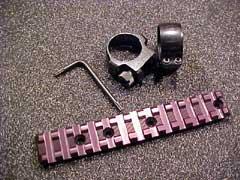
The Ruger Frontier Rifle
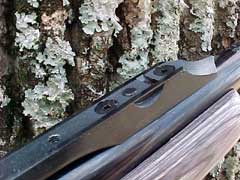
The Frontier Rifle features a quarter rib mounted on the
barrel just forward of the action. This rib accepts either the
included Ruger scope rings or the included Picatinny rail.

The quarter rib and Picatinny rail allows for a wide
variety of forward-mounted sights in a "scout rifle"
configuration. Jeff's favorite sight for this application is
the rugged Trijicon Reflex dot sight.
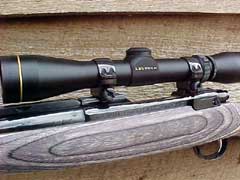
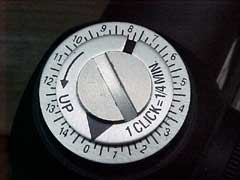
Like other Model 77 Mark IIs, the Frontier Rifle
includes scope mounts in the "conventional" position
over the action. This position is perfect for scopes such as
Leupold's superb VX-II 2-7x32.
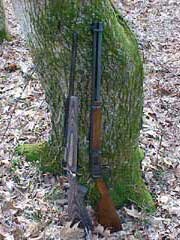
Ruger's Frontier Rifle is a very handy package,
comparing favorably to a standard 20-inch Winchester .30-30
lever gun.
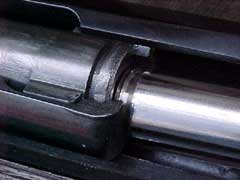
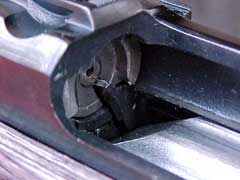
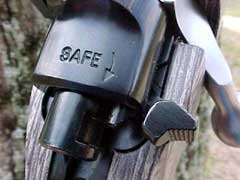
Built on Ruger's excellent Model 77 Mark II short
action, the Frontier Rifle features controlled round feed
(top), fixed blade ejector (center), and three-position safety
(bottom).
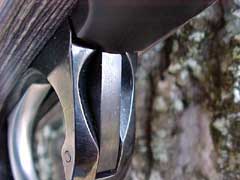
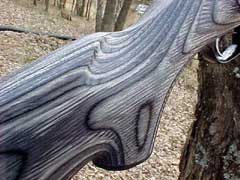
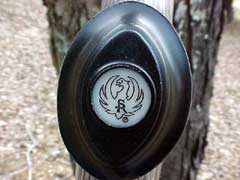
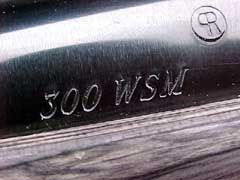
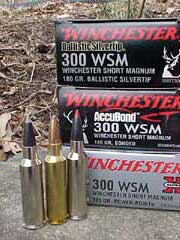
Author tested the Ruger Frontier Rifle with a variety of
Winchester factory ammunition. The little Ruger proved to be
both handy and capable of sub-MOA accuracy with all loads
tested.
|
![]()